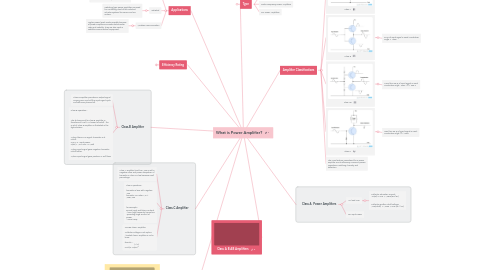
1. Type
1.1. Audio Power Amplifiers
1.2. Radio Frequency Power Amplifiers
1.3. DC Power Amplifiers
2. Applications
2.1. Consumer Electronics
2.1.1. Audio power amplifiers are used in almost all consumer electronic devices ranging from microwave ovens, headphone drivers, televisions and mobile phone.
2.2. Industrial
2.2.1. Switching type power amplifiers are used for controlling most of the industrial actuator systems like servos and DC motors.
2.3. Wireless Communication
2.3.1. Higher power levels made possible because of power amplifiers increases data transfer rates and usability. They are also used in satellite communication equipment.
3. Efficiency Rating
3.1. The maximum theoretical efficiency ratings of class-A, B, and C amplifiers are:
3.1.1. Class A - 25%
3.1.2. Class B - 78.9%
3.1.3. Class C - 99%
3.2. Efficiency, n=Pout/Pin Pout = power delivered to the load (ac power) Pin = total power supplied (dc power)
3.3. Power not delivered to the load will be dissipated by the output devices in the form of heat. Power dissipated, PD = VCEIC
4. Class-B Amplifier
4.1. Class B amplifier provides an output signal varying over one-half the input signal cycle and with zero phase shift.
4.2. Class-B operation:- The dc bias point for class-B amplifier is therefore at 0 volt. i.e. biased at cutoff . the Q pt of Class B amplifier is illustrated in the figure below:- *When there is no signal, transistor is at cutoff, ICQ = 0, input power, Pi(dc) = VCC.ICQ = 0 Watt *When input signal goes negative, transistor cutoff further *When input signal goes positive, IC will flows
5. Class-C Amplifier
5.1. Class- c amplifier load line, VBE is set to negative value and power dissipation of transistor in class-c is low because small percentage.
5.2. class-c operation:- transistor is bias with negative VBE transistor 'on' when Vin > VBB+VBE for example:- sinuod input and blips is output. - have high frequency harmonics -providing large amount of power. - nmax>98%
5.3. TUNED class-c amplifier. -collector voltage is not replica - loaded class-c amplifier is not in linear formula :- (1 / 2) F=I/2(3.142)LC^
6. Class A B AB Amplifiers
7. REFERENCE
7.1. Class A B AB Amplifiers
8. Amplifier Classifications
8.1. Class A
8.1.1. 100 % of input signal is used, conduction angle = 360o
8.2. Class B
8.2.1. 50 % of input signal is used, conduction angle = 180o
8.3. Class AB
8.3.1. More than 50 % of input signal is used, conduction angle 180o < θ < 360 o
8.4. Class C
8.4.1. Less than 50 % of input signal is used, conduction angle θ < 180o
8.5. The main features considered for a power amplifier are its efficiency, maximum power, impedance matching, linearity and distortion.
9. Class A Power Amplifiers
9.1. AC load Line:
9.1.1. Collector saturation current, IC(sat) = ICQ + VCEQ/(RC//RL) Collector-emitter cutoff voltage, VCE(cutoff) = VCEQ + ICQ (RC // RL)

